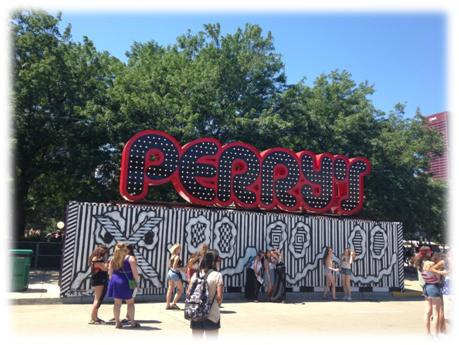Our newest consultant, Mike Stern, makes his home in Chicago. Aside from having to put up with amazingly bad baseball this summer, Chicago is also the place to take in a now-historic concert festival, Lollapalooza. Here are Mike’s reflections on this year’s event, with a few timely tie-ins to radio. – FJ
It was somewhere during the third day of Lollapalooza here in Chicago, amid the haze of dusty fields, sunscreen and Bud Light Straw-Ber-Ritas, that I started to think about how similar attending the festival is to listening to a radio station. So brace yourself because here comes a Lollapalooza-sized analogy.
Much like with a successful station, for Lollapalooza it all starts with the brand. Today, 22 years later, the festival is as strong as ever but that hasn’t always been the case. There was a hiatus around the turn of the century, a revival in 2003 and a disastrous 2004 tour that was cancelled due to poor ticket sales. It was those tough times though, that led to the current stationery three-day festival that draws upwards of 100,000 attendees each day.
Lolla’s longevity speaks to the value of having a brand that is innovative and stands out from the crowd. The original tour, which featured Alternative’s biggest acts along with Hip Hop artists and unique performers like the Jim Rose Circus Side Show, was unheard of at the time. That earned the brand a place in fans’ hearts and minds that endured through the tough times.
 It also points to the importance of being able to evolve. Founder Perry Farrell seems to have moved gracefully into the background. His main representation at the festival now is as the namesake of Perry’s, an EDM-fueled dance stage that attracts a lot of young people many of whom probably couldn’t name the lead singer of Jane’s Addiction. It’s a story all heritage brands could learn from. Often, there comes a time when even the most emotional of connections to a brand’s past have to be minimized or severed so a new generation can make it their own.
It also points to the importance of being able to evolve. Founder Perry Farrell seems to have moved gracefully into the background. His main representation at the festival now is as the namesake of Perry’s, an EDM-fueled dance stage that attracts a lot of young people many of whom probably couldn’t name the lead singer of Jane’s Addiction. It’s a story all heritage brands could learn from. Often, there comes a time when even the most emotional of connections to a brand’s past have to be minimized or severed so a new generation can make it their own.
I also noticed that the audience at Lolla is also a lot like a station’s listeners. Some attendees are hardcore music fans; some just come for the headliners and some only to hang out with friends: P1’s, P2’s and P3’s respectively. Just like a successful station, this requires the promoters to strike a balance between unknown, up-and-coming acts and established headliners while creating a great overall experience; something the Lollapalooza team does very well.
Then there are the bands themselves who are very much like a station’s airstaff; when they aren’t engaging, the whole experience is simply not as good. This past weekend I saw a startling number of bands who played their music without any showmanship or crowd interaction. Even Trent Reznor, who did an amazing set, kept the video screens shut off, leaving a lot of attendees (mostly the more casual fans who didn’t fight to the front of the stage) unable to fully enjoy his performance. The result was, time and again, bands who could have converted P2 and P3 listeners into hardcore fans let the opportunity slip away by not maximizing the entertainment experience.
Of course, like a station, Lollapalooza has advertisers to deal with as well. To their credit, the organizers do a good job of keeping the sponsors at bay and making sure that the majority of participating brands offered benefits to the fans. One friend of mine picked up everything from a free extra battery for her smartphone to food vouchers and tote bags – just for showing up at advertiser tents and tweeting or taking part in other reasonable activities. As an attendee, perks that made the sponsorships feel mostly unobtrusive were most welcome, another goal stations should strive for in integrating advertisers to on-air programming.
And then there’s research. In an interview that ran in the newspaper the day after the festival, one of the organizers talked about timing the lines at the different port-o-john set-ups and admitted that the results were unacceptable. They are already thinking about revising the flow for next year. That attention to detail and investment in finding the right answers is part of what makes the festival so much fun to attend.
In addition to timing bathroom goers, I’m quite sure the organizers were also taking more extensive crowd surveys. And while I wasn’t asked, and surely can’t speak for the other 299,999 attendees, I can say that when it comes to measuring my Net Promoter score, on a scale of 0-to-10, I would rate Lollapalooza a 9 based on how likely I would be to recommend the festival to a friend. It would have been a 10 if they had just talked Trent Reznor into using the video screens.
Branding, innovation and creating an engaging entertainment experience are all valuable lessons for radio stations to consider. Now if I can just convince Fred to expense my tickets for next year, I’ll be all set.
- Media And Technology In 2025: Believe It Or Not! - April 18, 2025
- In Radio, You Just Never Know - April 17, 2025
- The Secret To Making A Great Podcast (And Great Radio) - April 16, 2025




Way to convert it into a work event! 🙁 Seriously, really enjoyed the article:)
I know Dave it’s my hopeless obsession.
Thanks for the kind words.